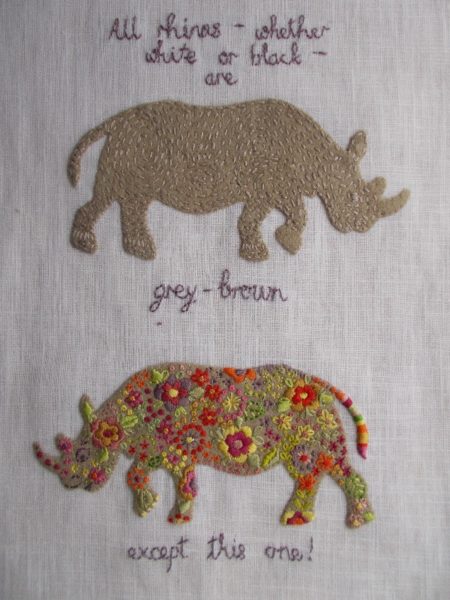
‘All rhinos are grey’ embroidery (hand embroidered by Mary Addison)
Daughter No 3 chastised me recently for not receiving much – well, ok, any – of my embroidery. She’s right, but as with daughter No 2, she hasn’t because both have been living the sort of life where heaping more possessions on them seemed a bad idea. Then daughter No 3 further reminded me that I had long promised I would embroider her a rhino (and I know Daughter No 3, is echoing this with her request for a cow), so blow to all my overthinking, I’d better get on with a rhino and make up for my neglect.
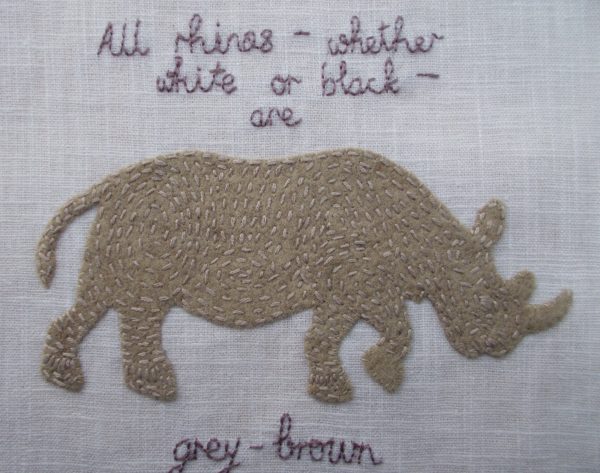
Detail : ‘All rhinos are grey’ embroidery (hand embroidered by Mary Addison)
I can never remember the difference between the two main species of rhino (there are 5 in all) – the white and the black, but one helpful thing I have learnt is that the difference has nothing to do with colour. Both are grey – well, usually a browny grey as they do enjoy a regular mud bath which, to be fair to them, is also helpful in protecting their skin from flies and even too much sun.
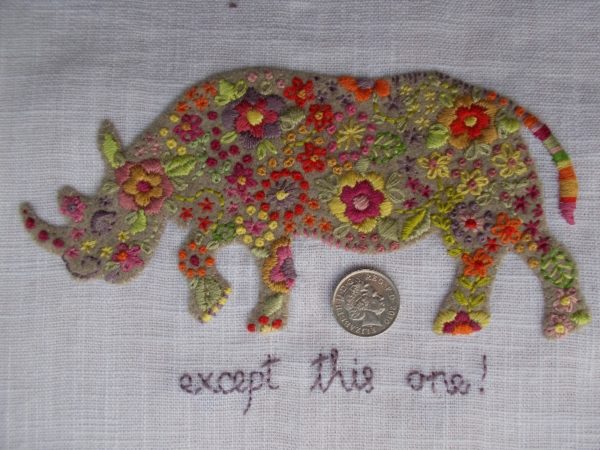
Detail: ‘All rhinos are grey’ embroidery (hand embroidered by Mary Addison)
The major difference between the white and the black rhino is, however, shape of the mouth and interestingly from this many of the other differences follow.
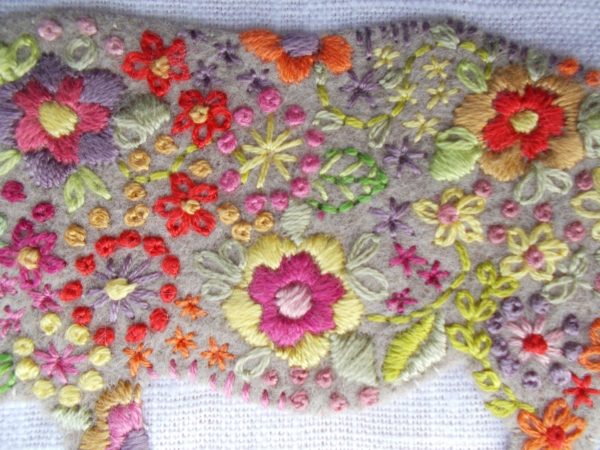
Detail : ‘All rhinos are grey’ embroidery (hand embroidered by Mary Addison)
The white rhino: Between a half and a third bigger than the black rhino with a barrel like body. A wide, flat squarish, very muscular lip declares its possessor to be a grass grazer, as does the usual posture – hoover like, head down close to the ground as it mows its way through the voluminous amounts of grass needed to fuel an animal of such a size. A rather flat back is interrupted by a little distinctive hump about three quarters of the way along. Eyesight is generally poor and with a nose habitually close to the ground, its ears have evolved to be the most important sensor of danger. Long and funnel like to catch and amplify sounds, these are constantly on the move, pivoting and twitching like little radar dishes, even when the animal is at rest. The first horn tends to be longer than the more stunted looking second horn. The white rhino is thought of as being more placid, although some think this is because, being an animal grazing on areas of open grassland, they have more warning of advancing danger. White rhino poo is a morrass of half digested matter and looks much like the product of a day’s domestic lawn mowing, although dark, almost black because of the presence of high levels of melanin found in the grass.
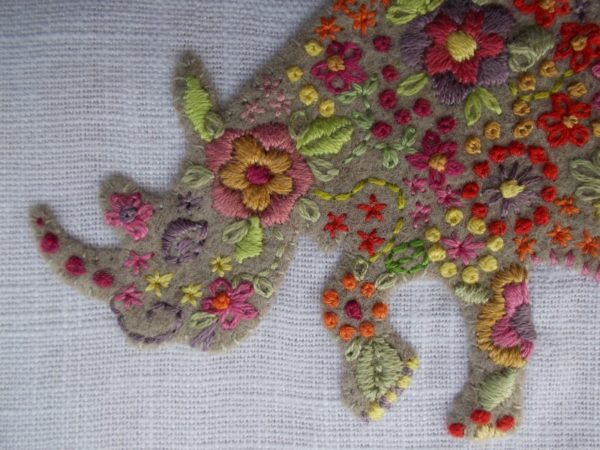
Detail: ‘All rhinos are grey’ embroidery (hand embroidered by Mary Addison)
The black rhino, with its pointed, hook-like lip (prehensile and with the dexterity reminiscent of an, albeit abbreviated, elephant’s trunk) has little problem with picking fruit and leaves from even spine-covered trees and shrubs. Such a feeding pattern has made the neck strong and the head is often held high, especially if there is a hint of danger. Small ears indicate no over reliance on hearing which is just one of the senses at its disposal. The animal’s fabled aggression may in part be due way the head is held high, permitting eye contact but it may also be because it is easier to get close to a black rhino as it feeds in the thickness of thorn bushes. The two horns are similar in length. Black rhino poo is also full of partially digested material but remarkably this visibly includes large parts of twigs or small branches – all of which are ground off at a perfect 45 degree angle – and what a digestive tract they must have to avoid punctures!
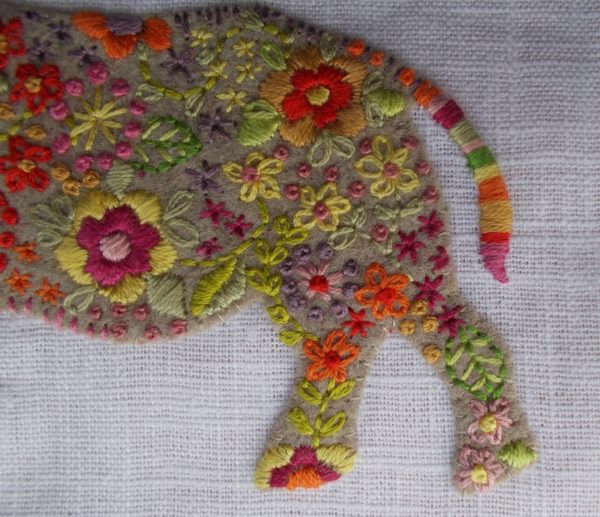
Detail: ‘All rhinos are grey’ embroidery (hand embroidered by Mary Addison)
I think I have embroidered a white rhino – head down, barrel bodied, slight bump towards the tail, one horn longer but that was more by luck than judgement!
Thanks to this blog from London Zoo (or ZFL as we now have to call it) by Amy Attenborough (what else could she be but a zoologist with a name like that). Do look at it for photographs and diagrams which show the differences more clearly than I can.

10 Comments
I love your flower-bedecked rhino. He’s a charmer!
That’s kind, Rachel.
Finally!!! Love it mum!! Thank you! Xxx
Glad you love it – thanks for saying so.
Where is my cow???
How do you know I haven’t done it? (Yes, you’re right, I’d have blogged about it if I had!) much love mum
Oh Mary, you are a wonder! What a fun embroidery project. Thanks also for all the detailed information about the rhino
Thank you for being so enthusiastic, Nella.
Beautiful as always. You might enjoy the book The last Rhinos by Lawrence Anthony. Kind of a swashbuckling account of rhino conservation efforts by the author.
That sounds like a book right up daughter No 3’s street. Thank you for recommending it, Amara.
One Trackback
[…] of tea, but I’m quite sure it’s a good present for Daughter No 2 because when I did these embroideries of rhinos here, (and also above and below) she reminded me that she still expected an embroidery of […]